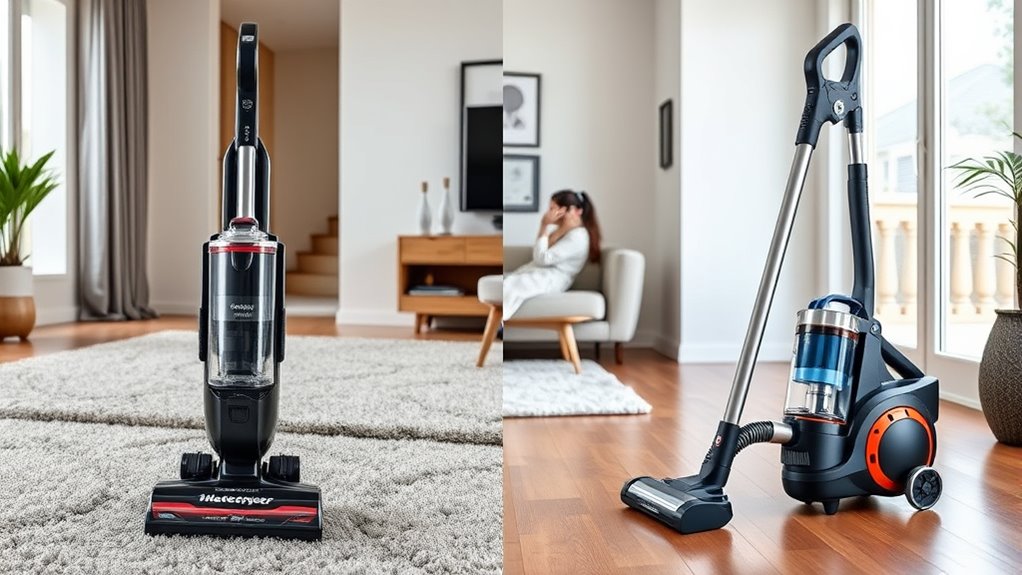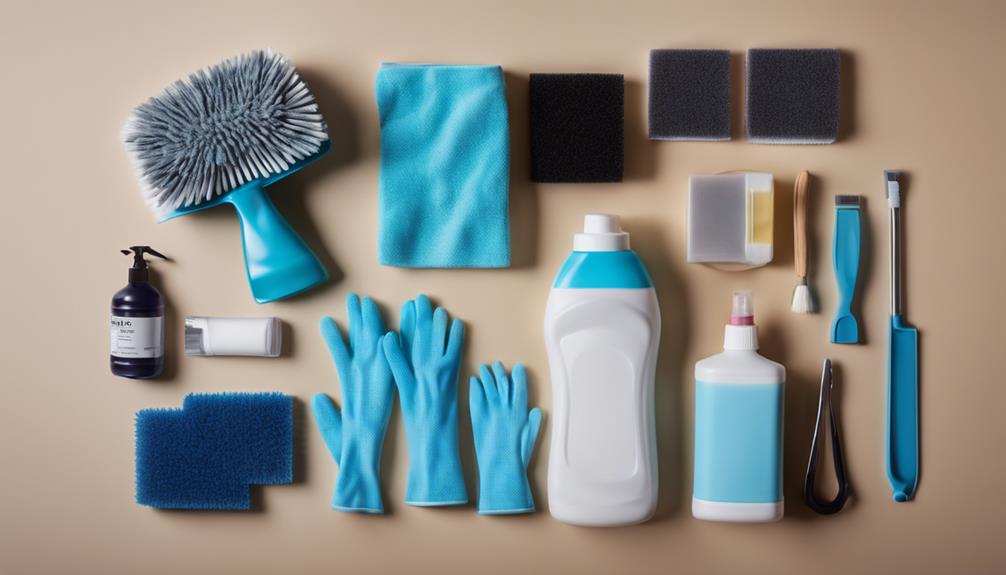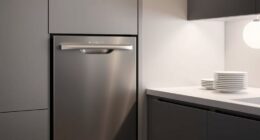Upright vacuums excel at deep cleaning carpets, are easy for quick all-over cleans, and work well on large areas, but they can be bulky and less maneuverable in tight spaces or on stairs. Canister vacuums offer superior versatility, easier handling, and better reach under furniture, making them ideal for homes with mixed floors. Each has pros and cons depending on your home’s needs. Keep exploring to discover which vacuum suits your space best.
Key Takeaways
- Upright vacuums excel on carpets and large areas, offering deep cleaning but are bulky and less maneuverable.
- Canister vacuums provide superior versatility, easy handling, and are ideal for stairs and tight spaces.
- Uprights are generally more powerful for pet hair removal and quick, large-scale cleanups.
- Canisters require more maintenance and can be noisier, but they handle various surfaces effectively.
- Choose upright vacuums for big, open spaces with carpets; opt for canisters for homes with mixed flooring and furniture.
Advantages and Disadvantages of Upright Vacuums
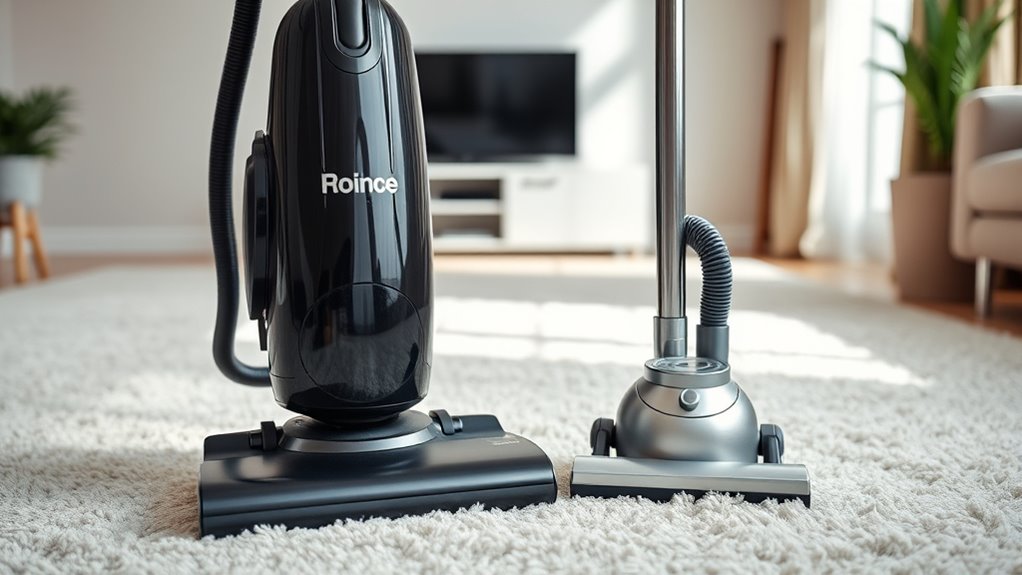
Upright vacuums are popular for their powerful suction and ease of use, making them a go-to choice for many households. One major advantage is their deep cleaning ability, especially on carpets. However, traditional upright models can be bulky, limiting maneuverability and storage options. Cordless convenience isn’t typically available with standard upright vacuums, which means dealing with cords and outlets can be cumbersome. If you’re budget-conscious, upright vacuums often come in a range of prices, but high-end models can be costly. While they excel at cleaning large areas quickly, they might not be ideal for tight spaces or stairs. Overall, upright vacuums are great for deep cleaning, but their size and cord dependence can be drawbacks depending on your needs. Additionally, their size and weight can make them less suitable for frequent stair cleaning or reaching high areas. For households with limited storage space, their bulkiness can be a significant concern. Furthermore, some models incorporate advanced filtration systems that improve air quality during cleaning. A versatile design can also enhance their functionality across different surfaces and cleaning tasks.
Advantages and Disadvantages of Canister Vacuums
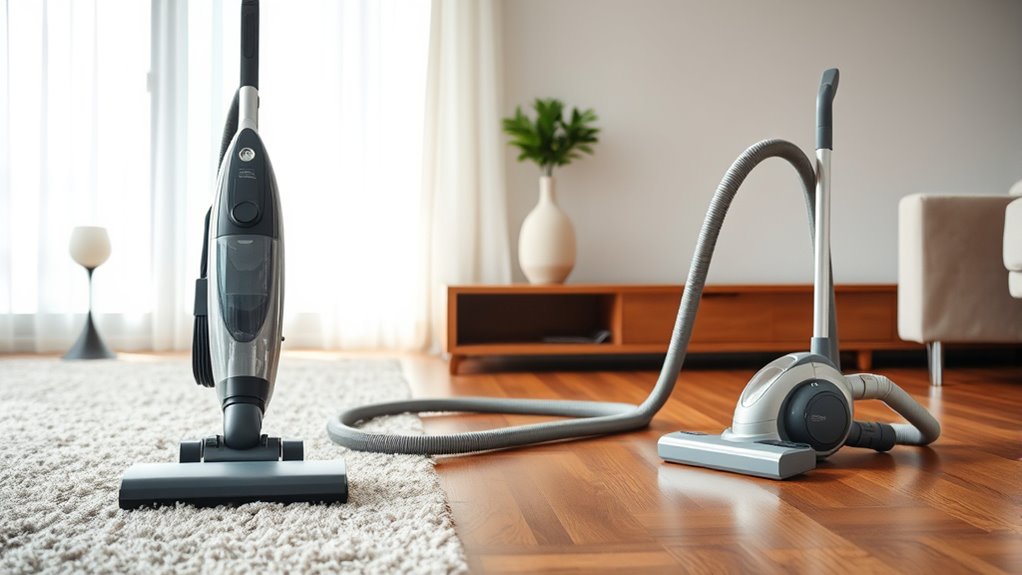
Canister vacuums offer notable versatility and ease of maneuverability, making them a popular choice for many households. They excel in reaching tight spaces, stairs, and delicate surfaces, thanks to their lightweight design. With cordless convenience, some models allow for greater mobility without worrying about cords, though traditional models may still have cords that limit movement. One disadvantage is that canister vacuums tend to have higher noise levels compared to uprights, which can be disruptive, especially in shared living spaces. Additionally, they can be more cumbersome to store and may require more maintenance due to their multiple components. Proper maintenance routines can help mitigate some of these issues and prolong the lifespan of the vacuum. Incorporating performance upgrades, such as more efficient filters and motors, can further enhance their cleaning effectiveness. When choosing a canister vacuum, it’s important to consider storage options to ensure it fits well in your space. Despite these drawbacks, their versatility and ease of use make them an excellent option for thorough cleaning in various environments. Understanding vacuum types can help you choose the best model to suit your cleaning needs.
Best Cleaning Situations and Home Environments for Each Type

Choosing the right vacuum depends heavily on your home environment and cleaning needs. If you have hardwood floors, an upright vacuum with a gentle brush roll can efficiently clean dirt without scratching the surface. Uprights are great for quick, all-encompassing cleanups across large areas. They excel at pet hair cleanup, especially if equipped with strong suction and specialized attachments. Canister vacuums are ideal for homes with varied flooring types or tight spaces, offering easy maneuverability and versatile attachments. They handle pet hair and debris on hardwood floors with ease and are perfect for cleaning under furniture or in hard-to-reach areas. Additionally, paying attention to suction power and filtration systems can significantly improve cleaning performance and air quality. Proper vacuum maintenance can also prolong the lifespan of your appliance and maintain optimal performance. Considering vacuum ergonomics can further enhance comfort during cleaning sessions, especially for larger areas or extended use. Moreover, selecting a vacuum with adjustable settings can help tailor the cleaning experience to different surfaces and reduce wear on the device.
Frequently Asked Questions
Are Upright Vacuums Better for Pet Hair Removal Than Canisters?
You might find upright vacuums better for pet hair removal, especially on carpets. They typically have stronger suction and wider brushes, making carpet cleaning more efficient and effective at picking up stubborn pet hair. Canisters are versatile but may lack the power needed for deep carpet cleaning. For pet owners prioritizing quick, thorough removal of pet hair from carpets, uprights often provide a more convenient and efficient solution.
How Do Maintenance Costs Compare Between Upright and Canister Vacuums?
Did you know that the average annual repair expenses for vacuum cleaners are around $50? When comparing upright and canister vacuums, upright models generally have higher cost maintenance due to more complex parts and heavier wear. Canisters tend to be cheaper to repair because they have simpler mechanics. Overall, if you want lower repair expenses, canisters might be the better choice, but regular maintenance keeps both running smoothly.
Can Canister Vacuums Easily Clean High or Hard-To-Reach Places?
Canister vacuums make it easy to clean hard-to-reach areas and high places because of their lightweight design and flexible hoses. You can effortlessly maneuver around furniture, reach ceilings, and clean tight spots without much effort. Their slim profiles help you access spaces that upright vacuums might struggle with, making them ideal if you want efficient cleaning of high surfaces or tricky corners.
Are Upright Vacuums Suitable for Cleaning Delicate or Fragile Surfaces?
Imagine walking on a glass bridge—delicate, requiring careful steps. Upright vacuums aren’t ideal for cleaning fragile materials or delicate surfaces because their powerful suction and stiff brushes can cause damage. You’d want a gentler approach, like a soft brush or handheld cleaner, to prevent scratches or tears. So, for fragile surfaces, stick to tools specifically designed for delicate materials; upright vacuums may not be suitable.
Which Vacuum Type Is More Energy-Efficient for Regular Cleaning?
When choosing a vacuum for regular cleaning, consider energy consumption and power efficiency. Generally, canister vacuums tend to be more energy-efficient because they often use less power while still providing strong suction. Uprights may consume more energy due to their larger motors. So, if you want to save on electricity and keep power efficiency high, a canister vacuum is usually the better choice.
Conclusion
Choosing between an upright and a canister vacuum depends on your cleaning needs. If you want powerful, easy-to-maneuver cleaning for carpets, an upright’s your best bet. For versatile, lightweight cleaning around furniture and stairs, a canister works wonders. Think of it like selecting a trusty steed—each has its strengths. Whichever you pick, you’ll keep your home tidy and cozy, just like a good ol’ Sunday morning in your favorite armchair. Happy cleaning!
